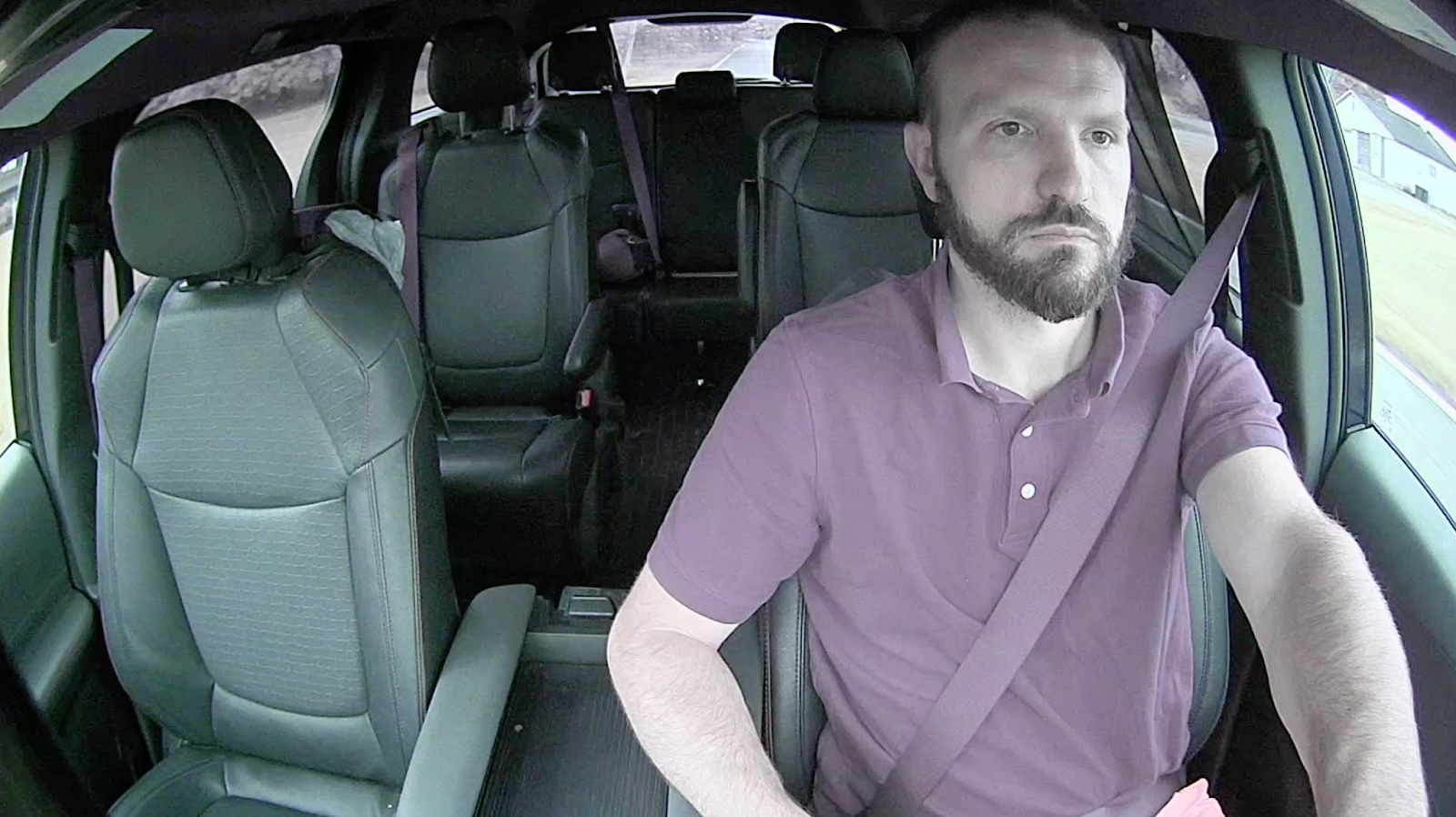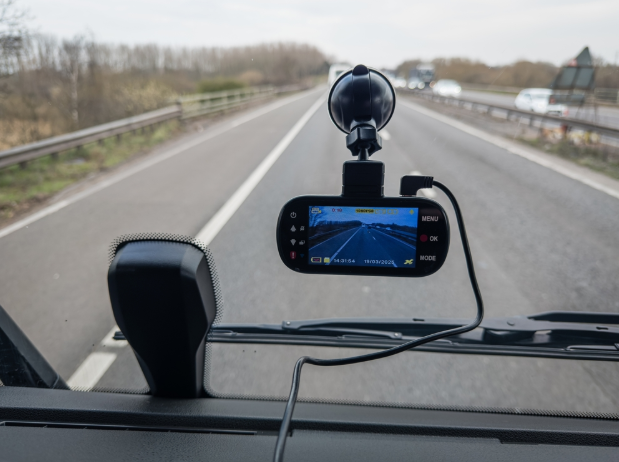A fleet camera system is a network of vehicle-mounted cameras that capture, store, and analyze video footage from commercial vehicles in motion or at rest. It’s used by fleet managers to improve safety, accountability, and operational efficiency.
Modern systems go beyond simple recording, as they use video telematics and AI to connect footage with real driving data, providing insight into what’s happening on the road and inside the cab in real time. For companies managing dozens or hundreds of vehicles, these systems are becoming as essential as GPS tracking.
Below is a breakdown of what a modern fleet camera system includes, how it works, and what to look for when evaluating providers.
1. High-quality dash cams for trucks
The foundation of any fleet camera system is the dash cam. Modern dash cams for trucks record both the road ahead and the driver’s cab, offering a complete picture of every trip. The forward-facing view captures traffic conditions and potential hazards, while the inward-facing camera provides context during incidents.
Track Star’s camera integrations support both configurations and automatically sync footage with telematics data such as speed, braking, and GPS position. This linkage gives safety teams an accurate timeline of events rather than isolated clips.
A good dash cam should record in at least 1080p HD, operate in low light, and handle vibration and temperature changes common in heavy-duty environments.
Fleet managers should also ensure the cameras can be updated remotely, reducing downtime for firmware updates or configuration changes.
2. Real-time alerts and video event detection
A fleet camera system isn’t useful if footage sits on an SD card until something goes wrong. The best setups feature live video telematics, using built-in AI or G-sensor data to detect risky events such as harsh braking, speeding, or tailgating.
When paired with telematics software like Track Star, these events trigger instant notifications to safety managers. This means a dispatcher or manager can review the clip within seconds, assess the severity, and decide whether to intervene. Over time, this builds a library of actionable insights that guide training and improve driver behavior.
A case study by Holman found that fleets using driver safety programs supported by video telematics and analytics reduced preventable claims by 65% over two years. These results highlight how real-time event detection and footage review help safety teams focus on meaningful incidents instead of sorting through hours of recordings.
3. Driver footage analysis and behavior coaching
Recording is only half of the equation. A comprehensive system must include driver footage analysis to identify patterns such as distracted driving, lane departure, tailgating, or fatigue. The most effective systems don’t use footage to punish drivers, but to coach them with specific examples.
For example, Track Star’s video analytics connect footage to driver IDs, time stamps, and vehicle data, helping managers build fair and objective driver scorecards. Reviewing this data in coaching sessions builds trust and demonstrates that the company’s focus is on safety, not surveillance.
AI-based analysis tools can automatically flag high-risk behaviors and score performance trends over time. This helps prioritize who needs training and prevents minor habits from turning into serious violations.
4. Cloud storage and remote accessibility
Fleet camera systems generate significant amounts of data. Without proper storage, valuable evidence can be lost or overwritten. The best systems use cloud-based storage with configurable retention policies so users can access video anytime, anywhere.
Track Star’s video telematics integrates secure cloud storage directly within its platform, ensuring video clips are linked with trip data and incident reports. This single source of truth simplifies reporting and compliance audits.
Cloud accessibility also enables remote investigations, whether you’re verifying a delivery, checking a claim, or reviewing a speeding event. Authorized users can pull footage without waiting for a driver to return to base.
5. AI-enabled safety insights
Artificial intelligence is changing how fleet camera systems operate. Instead of manual video review, AI now identifies behaviors such as phone use, following distance, and unsafe lane changes. It can also detect environmental factors like poor visibility or heavy traffic that contribute to driver stress.
Track Star’s integrated AI features analyze driver performance in context. For example, it can differentiate between a legitimate evasive maneuver and aggressive driving, reducing false positives.
These insights help fleets set realistic policies, improve insurance negotiations, and align safety programs with actual risk patterns.

6. Seamless integration with GPS and telematics
One of the biggest challenges with legacy camera setups is fragmentation; separate systems for location tracking and video. When incidents occur, teams waste time matching timestamps and reconciling reports.
Track Star solves this with a unified platform that integrates GPS tracking, maintenance data, and video telematics in one interface. This allows fleet managers to view a vehicle’s route, speed, and footage from a single timeline.
This integration also improves ROI. Instead of paying for multiple licenses or logins, everything is consolidated. In operational terms, this reduces investigation time, improves accountability, and ensures your compliance documentation is always synchronized.
7. Compliance and data security
Fleet camera footage often serves as legal evidence, so compliance and data protection are critical. Systems should meet GDPR or equivalent data-handling standards, depending on jurisdiction.
Track Star’s platform follows government-grade security protocols used by public safety and municipal fleets. Footage is encrypted both in transit and at rest, ensuring that sensitive data remains protected.
When selecting a provider, it’s worth confirming where video is stored, how long it’s retained, and who has access. Compliance isn’t only about regulations, as it also protects the company’s credibility and builds driver confidence.
8. Easy setup and scalability
A fleet camera system should grow with your operation. Whether you’re managing a dozen vehicles or several hundred, installation and scaling should remain straightforward.
Track Star’s hardware-agnostic design allows it to work with existing cameras and OEM systems. This avoids costly retrofits and minimizes downtime. New vehicles can be added with minimal configuration, and updates are handled remotely.
Look for systems that support mixed fleets: light-duty trucks, heavy-duty rigs, and specialty equipment. Scalability is a key differentiator between consumer-grade dash cams and enterprise-ready video telematics.
9. Data-driven ROI and insurance benefits
Beyond safety, fleet camera systems deliver measurable ROI. Insurers increasingly offer premium discounts for fleets equipped with verified telematics and camera systems. Video evidence also shortens claim resolution times, reducing payouts and administrative costs.
Track Star customers have reported significant cost savings after integrating cameras with their GPS tracking. And by quantifying ROI, they can justify their entire investment and create a data-backed narrative for safety initiatives.
10. Ongoing support and training
The best technology is only as good as the people using it. Continuous support ensures that teams can adapt to evolving features and regulations.
For instance, Track Star offers implementation assistance and training to help organizations get the most out of their video telematics systems. Regular feature updates and customer success guidance keep fleets ahead of compliance and safety requirements.
Support is especially important for government and utility fleets, where procedures and documentation standards are strict. Having a responsive partner makes the difference between compliance confidence and operational risk.
Final thoughts
A modern fleet camera system does far more than record video. It’s a connected safety and performance tool that transforms how fleets monitor, train, and protect their drivers. When powered by video telematics, real-time alerts, and cloud connectivity, it becomes a vital component of fleet operations.
If your fleet still relies on standalone dash cams or fragmented systems, now is the time to explore what integrated fleet camera technology can do for your operations.
Request a demo with Track Star today and see how easily you can bring visibility, safety, and accountability together.
Frequently asked questions
1. What is the best fleet camera system for safety?
The best fleet camera system for safety is Track Star, because it combines dash cams, real-time alerts, and video telematics. It also offers integrated camera options with driver analysis, cloud storage, and GPS tracking in one platform.
2. How does a fleet camera system improve driver performance?
A fleet camera system improves driver performance by recording and analyzing behavior such as speeding or distraction. Platforms that include AI-powered video telematics even provide feedback and coaching tools that help reduce risky habits and prevent incidents.
3. Can fleet camera systems reduce insurance costs?
Yes. Many insurers offer discounts when fleets use dash cams and video telematics to verify incidents. The integrated footage and analytics simplify claims handling and strengthen documentation for insurance negotiations.
4. What should a fleet camera system include in 2025?
A modern fleet camera system should include high-definition dash cams, AI event detection, cloud storage, and GPS integration. Track Star’s unified solution includes all of these, helping fleets manage footage, safety, and maintenance together.
5. Are fleet camera systems worth it for small or mid-sized fleets?
Yes. Even smaller fleets benefit from video telematics by gaining visibility into driver habits and protecting against false claims. Scalable systems allow fleets to start small and expand as their needs grow.


.png)